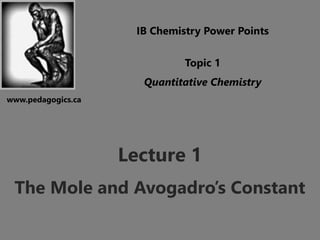
2016 topic 01 part 1
- 1. IB Chemistry Power Points Topic 1 Quantitative Chemistry Lecture 1 www.pedagogics.ca The Mole and Avogadro’s Constant
- 2. the Mole
- 3. A mole is a unit of quantity. A mole is 6.02 x 1023 things. 6.02 x 1023 is known as Avogadro’s constant (NA) ÷ 6.02 x 1023 Number of atoms, molecules or fundamental units Number of moles (mol) × 6.02 x 1023
- 4. The Mole Consider one molecule of water How many molecules in 2000 cm3 of water? 6.7 x 1025 molecules
- 5. The Mole 6.7 x 1025 molecules is not a manageable number. Consider: We count eggs by the dozen We measure long periods of time in centuries. We measure long distances in our universe using light years.
- 6. The Mole There are many ways of measuring large quantities that utilize large units. The mole is one such unit. The mole is the SI unit for chemical quantity used to count the particles in a sample of pure substance. One mole = 6.02x1023 particles. “One mole of anything = 6.02x1023 units of that thing”
- 7. The Mole How many molecules of water in 2000 cm3? 6.7 x 1025 molecules Or 111 mol meaning 111 moles of water molecules. This is a much more manageable number.
- 8. How many atoms are in 0.065 mol of copper? 3.9 x 1022 How many molecules are in 0.065 mol of CO2? 3.9 x 1022 How many formula units are in 0.065 mol of NaCl? 3.9 x 1022 How many moles is 9.03 x 1023 atoms of copper? 1.5 How many moles is 9.03 x 1023 molecules of CO2? 1.5 How many moles is 9.03 x 1023 formula units of NaCl? 1.5
- 9. How many oxygen atoms are in 1.4 x 10-7 mol of oxygen gas (O2)? (1.4 x 10-7) × NA = 8.428 x 1016 molecules of O2 2 atoms of oxygen per molecule so final answer = 1.7 x 1017 atoms of oxygen (2 SF) Given 1.76 x 1012 molecules of O2, how many moles of iron III oxide (Fe2O3) can be assembled? 12 1.76 10 molecules O 2 atoms/molecule 2 23 6.02 10 3 atoms/molecule 12 1.95 10 moles Fe O 2 3
- 11. What are chemical formulae? ● short-hand notation ● tells us the types of elements in a compound ● gives the number of atoms of each type of element in one molecule of the compound H2SO4 sulphuric acid 4 atoms of oxygen 1 atom of sulfur 2 atoms of hydrogen 1 molecule of H2SO4
- 12. How many atoms? C6H12O6 glucose Mg(NO3)2 magnesium nitrate Cu(SO4)2●5 H2Ocopper II sulfate hydrate
- 13. Relative Formula/Molecular Mass (MR) The average relative atomic mass (AR) for each element is noted on the Periodic Table. For example AR for copper is 63.55. Relative masses are based on 1/12th the mass of a 12C atom. The relative formula mass is the total mass of the atoms in one molecule of a particular compound. For example H2SO4: Hydrogen 2 atoms × 1.01 = 2.02 Sulfur 1 atom × 32.07 = 32.07 Oxygen 4 atoms × 16.00 = 64.00 MR 98.09
- 14. Molar Mass
- 15. Mass and the Mole: Why 6.02×1023? Consider 1 atom of sulfur AR = 32.07 = 5.326×10-23 grams Consider 1 mole of sulfur = 6.02×1023 atoms = 32.07 grams 1 mole = 6.02×1023 was chosen because this was then number of carbon-12 atoms that has a mass of 12 grams.
- 16. Aluminum AR = 26.98 gram atomic mass = 26.98 g mol-1 Carbon dioxide (CO2) MR = 44.00 gram molecular mass = 44.00 g mol-1 Sodium chloride (NaCl) Language issue gram atomic mass gram molecular mass gram formula mass MR = 58.44 gram formula mass = 58.44 g mol-1 MOLAR MASS
- 17. We weigh chemical quantities in grams. The molar mass value for a substance allows us to determine the number of moles from a measured mass. Consider 5.68 g of MgCl2 Molar mass of MgCl2 = 95.21 g mol-1 -1 5.68 g =0.0597 mol 92.51 g mol 0.0597 moles of MgCl2 molecules or…. 0.0597 moles of Mg atoms or…. 0.119 moles of Cl atoms
- 18. Atoms combine to form compounds in chemical reactions. These combinations occur in whole number ratios (chemical formulae) – it is the number of each type of atom that is important (we count numbers with MOLES) We measure chemical quantities by MASS. Molar mass is a very important aspect of quantitative chemistry because it relates MASS to MOLES (number of atoms)
- 19. ÷ 6.02 x 10 Number of 23 atoms, molecules or fundamental units MOLES × 6.02 x 1023 MASS × molar mass ÷ molar mass molar mass
- 20. How many mole are in 45.0 g of water? 2.50 mol What is the mass of 1.75 mol of CO2? 77.0 g How many moles of oxygen atoms are in 300 g of CaCO3? 9 moles What is the mass of 9.03 x 1023 atoms of copper? 95.3 g 106 g of glucose (C6H12O6) is how many moles? 0.589 mol What is the mass of the oxygen atoms in the previous question? 56.5 g
